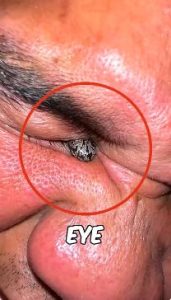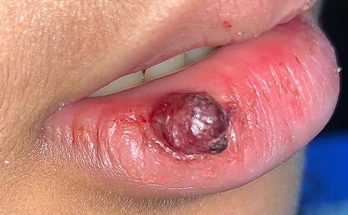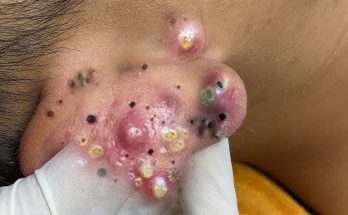Foreign bodies and abrasions are the most common conjunctival and corneal injuries. Foreign body removal techniques vary depending on the type of foreign body:
-
Surface foreign bodies are removed with irrigation and a moistened cotton-tipped applicator.
-
Embedded foreign bodies need to be removed on the point of a sterile spud (an instrument designed to remove ocular foreign bodies) or a 25- or 27-gauge needle, generally under guidance with a slit lamp.
-
Intraocular foreign bodies, or any penetrating injuries, are treated surgically by an ophthalmologist.
Indications for Removing an Eye Foreign Body
Suspected ocular foreign body
Contraindications to Removing an Eye Foreign Body
Absolute contraindications
-
None
Relative contraindications
-
Identified or suspected intraocular foreign body or other penetrating injury, which requires immediate ophthalmologic consultation
-
An uncooperative patient
The patient must be able to stare without moving the eye during foreign body removal. Ophthalmologic consultation should be obtained for patients who may be unable to cooperate (eg, young children, intoxicated adults).
Complications of Removing an Eye Foreign Body
-
Very rarely, perforation, risking endophthalmitis
Equipment for Removing an Eye Foreign Body
-
Slit lamp with cobalt blue filter (preferred) or binocular lens (loupes) with Wood light
-
Local anesthetic (eg, 0.5% proparacaine eyedrops)
-
Fluorescein strips
-
Sterile cotton-tipped applicators
-
Spud, or 25- or 27-gauge needle attached to tuberculin syringe
-
Low-speed rotary burr
-
Sterile saline and 10- to 20-mL syringe
Additional Considerations for Removing an Eye Foreign Body
-
If at any time you suspect the presence of an intraocular foreign body or other penetrating injury, stop the procedure and avoid putting any further pressure on the globe. Protect the globe with a rigid shield (seated on or beyond the bony orbital rim), give systemic antibiotics (eg, empiric cefazolin and gentamicin) and an antiemetic, and immediately obtain ophthalmologic consultation for evaluation and treatment.
Positioning for Removing an Eye Foreign Body
-
Seat the patient at the slit lamp and sit opposite to the patient during the removal procedure.
-
Stabilize the patient’s head (eg, make sure it is pressed securely against the forehead strap and chin rest of the slit lamp). An assistant may help maintain the patient in the proper position.
-
Keep your operating hand in contact against a bone on the patient’s face (eg, the zygomatic arch or the nasal bridge), so that if the patient moves, your hand will move in tandem.
Step-by-Step Description for Removing an Eye Foreign Body
-
Do a preprocedure eye examination, without topical anesthetic if the patient’s discomfort level permits. Using a penlight, externally examine the eye for deflation of the globe or anterior chamber. Check visual acuity, ocular motion and pupil size, shape, and reflexes. If you see signs of perforation, abort the procedure and obtain immediate ophthalmologic consultation (see Additional considerations, above).
-
If a topical anesthetic was not used before the preprocedure examination, ask the patient to look upward, and then place a drop of topical ocular anesthetic into the lower fornix of the affected eye. Tell the patient to keep the eye closed for about a minute in order to retain the drug.
-
Seat the patient at the slit lamp.
-
Apply fluorescein and examine the eye for the Seidel sign (disturbance of the surface fluorescein by a dark streaming of aqueous humor through a corneal or scleral perforation). If the Seidel sign is present, abort the procedure and obtain immediate ophthalmologic consultation.
-
Examine the eye for a foreign body. Retract the eyelids by placing your thumb just below the lower lid and your forefinger just above the upper lid and then spreading your thumb and forefinger apart. Inspect the entire conjunctiva and cornea. Have the patient look down when the upper fornix is inspected and look up when the lower fornix is inspected. Vary the beam width and angle on the slit lamp to examine a corneal foreign body and gauge its depth. Evert and double evert the upper eyelid. First, press gently on the superior part of the upper lid with a cotton-tipped applicator. Then, lift the upper lid margin upward and backward toward the patient’s forehead. Next, do double eversion by pushing caudally with the applicator until the superior fornix is visible.
-
If no foreign bodies or corneal abrasions are visible, or if only a simple corneal abrasion is visible, swab the upper and lower fornices with a moistened cotton-tipped applicator and then irrigate the eye as described in Eye Irrigation and Eyelid Eversion. If there is no history of chemical exposure, irrigating the eye with several fluid ounces of saline may be sufficient.
Removal of superficial foreign bodies
-
To remove a superficial foreign body from the conjunctiva or cornea, first gently irrigate the area (eg, using sterile saline in a syringe) to moisten the area and possibly dislodge the foreign body. Do not point the irrigating stream directly at the foreign body.
-
Use a moistened cotton-tipped applicator, with a rolling motion, to gently lift the superficial foreign body from the surface.
-
Use a delicate and circumscribed motion when touching the cornea with the moistened cotton-tipped applicator to avoid damaging the epithelium.
Removal of embedded foreign bodies
-
Remove an embedded foreign body using, according to your preference, a spud, a low-speed rotary burr, or a 25- or 27-gauge needle attached to a small (eg, tuberculin) syringe.
-
Hold these tools as you would hold a pencil.
-
Have the patient stare at an object straight ahead.
-
Always approach a corneal foreign body from the periphery of the cornea (ie, never cross the patient’s visual field with the removal tool) and use your dominant hand. Use 2 steps to make the approach.
-
First, without using magnification, position your operating hand (ulnar aspect) against the patient’s face (zygomatic arch or nasal bridge area) and maneuver the removal tool to a spot near the corneal periphery.
-
Next, under magnification, and holding the removal tool tangential to the corneal surface, slowly and carefully approach the foreign object, proceeding inward from the corneal periphery.
-
Hold the spud or needle with the bevel up, and then use the tip to pick or scoop the foreign object away from the cornea. You may need to repeat this procedure several times to fully remove the foreign body. This technique can also remove some superficial rust rings. If the foreign body has been dislodged but remains on the surface of the eye, try irrigation to rinse it away or use one of the same removal tools used to remove the foreign body.
-
Some nonophthalmologists avoid using the rotary burr. The burr is usually mentioned for removal of rust rings but can also be used to remove an embedded corneal foreign body. Gently and briefly press the rotating burr against the foreign body. Then retreat and assess how much was removed. Repeat until the foreign body (or rust ring) is removed. Always balance the amount removed against the size of the corneal defect being created by the burr. The burr creates a larger defect than a spud or needle. Reversing the direction of the burr is sometimes helpful (by reversing the spin direction). You need not remove rust rings; they can be addressed by the ophthalmologist at the 24-hour follow-up visit.
Aftercare for Removing an Eye Foreign Body
-
Test postprocedure visual acuity.
-
Instill fluorescein and verify continuing (postprocedure) absence of perforation (ie, absent Seidel sign).
-
Prescribe topical antibiotic ointment or drops (eg, ciprofloxacin 0.3% ointment or drops 4 times a day for 5 to 7 days).
-
Do not prescribe topical corticosteroids.
-
Do not prescribe a topical anesthetic.
-
Do not patch the eye.
-
Arrange 24-hour ophthalmologic follow-up or, if not feasible, tell the patient to seek emergency care if symptoms have not completely resolved in 24 hours.
Warnings and Common Errors When Removing an Eye Foreign Body
-
Do not use a cotton-tipped swab to remove an embedded corneal foreign body. A swab can damage large areas of the corneal epithelium.
-
Do not use a scleral lens for irrigation. It could further embed a foreign body into the cornea.
-
Risk of corneal perforation by a needle is low if the approach is tangential and your hand is anchored to the face
Tips and Tricks for Removing an Eye Foreign Body
-
Proceed from least invasive to more invasive; often a foreign body can be rinsed away with irrigation.



